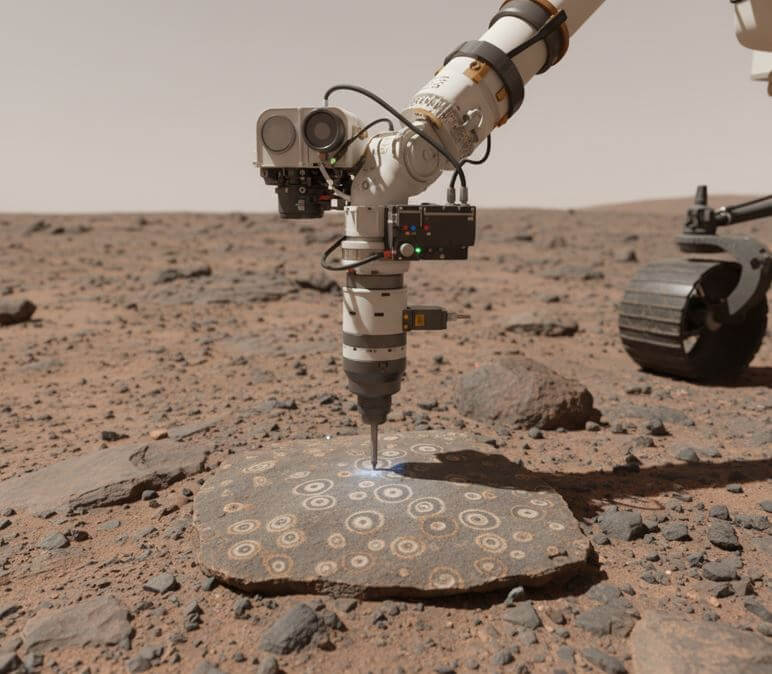Introduction: Why Mars? Our Eternal Curiosity
The scientific quest for life on Mars. Are we alone in this vast universe? This question is one of the deepest curiosities of human existence. In search of an answer, our gaze often turns to the sky, and especially to our nearest neighbor, the planet Mars. Its geographical proximity, some similarities to Earth, and its mysterious red color have made it a major focal point for human exploration. However, humanity’s fascination with Mars is not limited to modern scientists; it has played an important role in mythology, religion, and literature since the beginning of human history.
Ancient Romans named Mars after the god of war, ‘Mars,’ which was likely related to its reddish appearance. In Hindu mythology, the planet is also known as ‘Mangal’ and is personified as a warrior deity. These mythological connections were formed due to its red color, a symbol of war and destruction. Later, in the nineteenth century, with the improvement of telescopes, when Italian astronomer Giovanni Schiaparelli spoke of ‘canali’ or canal-like lines on the surface of Mars, the planet became a central point of scientific imagination. This was a mistaken belief, but based on it, H.G. Wells wrote his famous novel
The War of the Worlds (1898), where a more advanced but aggressive alien species invades a defenseless Earth.
This shift reflects the evolution of our perspective—a journey from religious and fictional concepts to scientific inquiry. When scientific data confirmed Mars’s rugged and hostile nature, the focus of speculation turned to the idea of ‘terraforming’ Mars, or making it habitable for humans. Modern literary works like Kim Stanley Robinson’s The Mars Trilogy highlight these scientific and social challenges. This evolution demonstrates how science helps us rewrite our cultural narratives.
In the present day, robotic explorations have given new dimensions to this long-standing curiosity. Missions like NASA’s Perseverance and Curiosity rovers are continuously enriching our knowledge about Mars’s past and present. These discoveries are not only expanding our understanding of Mars but also forcing us to reconsider our assumptions about the necessary conditions for the existence of life in the universe. This report provides a detailed overview of the long and complex journey of searching for life on Mars, where scientific discoveries, historical context, and the future aspirations of humanity are intertwined.
Chapter One: Once a Watery Mars: The Search for Past Life

Recent scientific discoveries have painted a compelling picture that the currently dry and cold Mars was once warm and rich in water. These discoveries are redefining our understanding of the fundamental conditions for life—the presence of liquid water.
Water-Formed Terrain: The Most Crucial Condition for Life
The first and most important step in the search for life on Mars is the discovery of liquid water. Our spacecraft have provided groundbreaking evidence on this front. The ground-penetrating radar (RIMFAX) instrument on NASA’s Perseverance rover has confirmed that its landing site, Jezero Crater, was once home to a vast lake and a river delta. Approximately 3.5 billion years ago, this region was water-rich and likely an ideal environment for microbial life to thrive.
In addition, NASA’s Curiosity rover found wave ripples in the Gale Crater region, which proves that about 3.7 billion years ago, Mars had lakes that were not covered in ice but were exposed directly to the atmosphere. This discovery has forced a re-evaluation of ancient Martian climate models, as some had hypothesized that the planet’s atmosphere at the time would have been so cold that liquid water could only exist as ice. These explorations suggest that water was not only on the surface but also in the depths of the planet. Analysis of seismic data from the European Space Agency’s (ESA) Mars Express mission and NASA’s InSight lander has provided strong evidence for the existence of ancient, and possibly current, reservoirs of liquid water beneath the Martian surface.
Footprints of Microbes: Potential Biosignatures
The most exciting discoveries in the search for life on Mars are features that may not be direct proof of life, but hint at the environment and biochemical activity necessary for it. Scientists refer to these kinds of signals as “potential biosignatures.”
In July 2024, the Perseverance rover collected a core from a rock named “Cheyava Falls” in the ‘Bright Angel’ region of Jezero Crater, which showed a peculiar pattern resembling “leopard spots”. These spots were not formed by purely geological processes but indicate biochemical reactions. The sample contained two important minerals,
vivianite (an iron phosphate) and greigite (an iron sulfide). On Earth, these two minerals are often formed in environments where microbes use organic matter for energy.
These mineral patterns create a “bullseye-like” arrangement, which on Earth, reflects electron transfer reactions driven by microbes in oxygen-free mud. These discoveries further support the idea that Mars once had an environment that could sustain microbial life. However, scientists are very cautious and refer to these signals as “potential biosignatures,” as they can also be formed by non-biological processes. This caution is part of a scientific framework called the “Confidence of Life Detection (CoLD) scale,” which sets specific steps for independent verification and ruling out non-biological explanations before making a final announcement.
The Discovery of Organic Molecules: The Building Blocks of Life
Carbon-based organic molecules are essential for the existence of plants and animals. Their presence on Mars hints at the chemical processes required for life. NASA’s Curiosity rover found the largest organic molecules—decane, undecane, and dodecane—in a rock sample from Gale Crater. These are believed to be fragments of fatty acids.
This discovery is significant for two reasons. First, it suggests that the chemical processes necessary for the origin of life on Mars may have reached a certain level of complexity. Second, it proves that despite the intense radiation and oxidation on the Martian surface, organic molecules can be preserved for millions of years. This is an important factor for future missions, as it suggests that we might be able to find the remnants of life.
This journey to find life on Mars follows a precise chain of cause and effect. First, rovers and orbiters confirmed the presence of vast amounts of liquid water on ancient Mars. This proves that the Martian surface was once habitable. Then, exploring these water-formed environments led to the discovery of carbon-based organic molecules , which are the essential ingredients for life.
The latest and most crucial step was Perseverance finding minerals and patterns ( vivianite, greigite, “leopard spots”) that, along with organic molecules, are associated with living microbial activity. This series of discoveries is the result of a deliberate scientific process and shows that scientists are not just looking for isolated data, but are solving a larger mystery.
There is a profound reason why scientists use cautious language like “potential biosignatures” instead of the word “life.” In the past, there were several false announcements about the existence of life on Mars and other planets, which put the credibility of the scientific community at risk. The CoLD scale was created as a formal framework to avoid this problem. It sets specific steps, from detecting a signal to ruling out contamination, eliminating non-biological explanations, and finally ensuring independent verification. This method not only upholds scientific integrity but also protects the public from misinformation and directs human curiosity along a realistic path.
Table 1: Key Rovers and Their Contributions to the Search for Life on Mars
| Mission Name | Landing Year | Main Rover | Key Contributions | |
| Mars Science Laboratory | 2012 | Curiosity | Evidence of ancient lakes in Gale Crater. Discovered long-chain organic molecules decane, undecane, and dodecane. | |
| Mars 2020 | 2021 | Perseverance | Evidence of an ancient lake and river delta in Jezero Crater. Discovered “leopard spots” and | vivianite, greigite minerals, which are potential biosignatures. |
| ExoMars (European) | Postponed (from 2022) | Rosalind Franklin | Designed to drill up to 2 meters deep to search for signs of life underground. | |
| Mangalyaan (MOM) | 2013 | MOM Orbiter | India’s first interplanetary mission. Collected images and data on the atmosphere and surface. |
Chapter Two: Present-Day Mars: The Possibility of Life in a Hostile Environment

If life existed on Mars in the past, could it still be there today? This question has turned scientists’ attention to the present, extremely hostile environment of Mars.
A Mysterious Gas: The Methane Enigma
The presence of methane gas in the Martian atmosphere is one of the most intriguing and debated topics. NASA’s Curiosity rover has recorded sudden spikes in methane gas in Gale Crater, with levels sometimes reaching 40 times their normal background. On Earth, most methane is produced through biological processes, such as the metabolism of microbes. But the source of Mars’s methane is still unknown. It could be created by living microbes, or it could be the result of geological processes, such as volcanic activity.
A new study has proposed an interesting hypothesis to solve this mystery: Mars’s methane might be trapped beneath a hard crust of perchlorate, a solid salt. According to this research, the methane could be released when this layer breaks due to changes in temperature during the day or the weight of a rover passing over it. This hypothesis provides a possible non-biological explanation for the irregular behavior of methane and is a perfect example of scientific debate. The sudden presence of methane initially created widespread excitement because one of its potential sources could be living microbes. However, the nature of scientific inquiry requires exploring all alternative explanations. The perchlorate salt layer hypothesis does exactly that. It presents a plausible model for the release of methane through a non-biological process. This event offers an important lesson on how science works: a single signal (like methane) is not enough; a theory must rule out all possible alternatives to be proven.
Extremophiles and Mars
The surface environment of Mars is extremely hostile to humans and most life forms on Earth. It has intense ionizing radiation, extreme cold, and a very dry atmosphere. But on Earth, there are some organisms (called ‘extremophiles’) that can survive in our planet’s most hostile environments, such as deep-sea vents or under Antarctic ice. It is possible that such life forms could exist on Mars, especially below the surface.
A few meters beneath the Martian surface, the soil provides protection from radiation. The temperature is relatively higher and more stable, and subterranean water could exist in a liquid state, especially in the presence of salt, which lowers the freezing point of water. This subterranean environment could still be suitable for microbial life, which adds to the curiosity about the potential biological source of methane. These explorations are not just about the possibility of life on Mars but also influence our understanding of the possibility of life in other extreme environments in the universe.
Chapter Three: Future Missions: The Grand Plan to Find Answers

While Mars rovers and orbiters have found potential signs of life, no definitive proof has been found. To find this final answer, one of humanity’s most ambitious space missions has been planned.
The Mars Sample Return (MSR) Mission: The Final Answer
The Mars Sample Return (MSR) is a joint effort by NASA and ESA, with the goal of bringing the rock and soil samples collected by the Perseverance rover back to Earth. This is essential for analysis in ultra-sensitive laboratories on Earth, which is impossible for a rover to do on Mars.
This mission is extremely complex and requires the coordination of multiple components:
- Sample Collection: The Perseverance rover has already collected rock and soil samples from Mars in 43 sealed tubes.
- Sample Retrieval: A Sample Retrieval Lander (SRL) will land on the surface of Mars, which will use a robotic arm (Sample Transfer Arm) and two small helicopters to collect the samples.
- Sample Launch: The SRL’s small rocket, the Mars Ascent Vehicle (MAV), will launch a container filled with samples into Mars orbit.
- Return to Earth: An Earth Return Orbiter (ERO) will wait in Mars orbit to capture the sample container and place it in a bio-sealed capsule to bring it back to Earth.
This mission is highly ambitious and faces immense challenges. The main obstacles are the high budget (estimated to be up to $11 billion and considered “infeasible”), schedule delays, and technical complexities. As a result, NASA has been forced to reconsider the implementation of this mission and is trying to create a more cost-effective plan. These challenges are not just financial or technical; they also highlight the tension between scientific priorities and political will. On one hand, the scientific community has identified the MSR mission as a “highest priority”. On the other, its massive cost and complexity have forced NASA to rethink its implementation.
Other Important Missions
- India’s Mangalyaan (MOM): The MOM (Mangalyaan) mission gave India the distinction of being the first Asian country to reach Mars orbit, and it was successfully completed on an extremely low budget. It took pictures of the surface and studied the atmosphere, especially methane. It was a successful example of demonstrating technological capability, which proves India’s capacity for future deep space missions.
- European Space Agency’s ExoMars Mission: The main goal of this mission is to find out if life ever existed on Mars. Its Rosalind Franklin rover is capable of drilling up to 2 meters deep, which is crucial for searching for signs of life in the radiation-free depths below the surface.
- China’s Planned Mission: China is also planning to return a sample from Mars in the 2030s.
Chapter Four: Human Missions to Mars: Dream and Reality
While robotic missions are continuing the search for life on Mars, humanity ultimately wants to establish its own existence there. This is a powerful connection between science and fiction.
When Will Humans Go to Mars?
Plans for human missions to Mars have been in the works for decades. Government space agencies, like NASA, have created a step-by-step roadmap for human missions to Mars, which depends on specific time periods for the orbits of Earth and Mars, which occur approximately every 26 months.
However, the most ambitious private initiative to make this dream a reality is Elon Musk’s SpaceX. Their goal is to establish a self-sufficient, large-scale colony on Mars, which would ensure the long-term survival of the human race. SpaceX’s plan is not just for one mission but to create an entire ecosystem. They are working on a strategy to use local resources on Mars, such as creating methane (
CH4) and oxygen (O2) from the carbon dioxide (CO2) in the Martian atmosphere and the water ice beneath the surface. This would drastically reduce mission costs and help achieve self-sufficiency. Elon Musk has proposed a timeline for the first human-crewed mission by 2029 and the establishment of a self-sustaining colony by 2050.
Preparing Mars for Habitation: Terraforming
The ultimate dream of establishing a human settlement on Mars is to make the planet habitable for humans, a process known as ‘terraforming.’ This involves thickening the atmosphere and increasing the temperature so that liquid water can flow on the surface again. This concept has inspired the work of authors like Kim Stanley Robinson, who has painted an epic picture of the science, technology, and human society involved.
However, there are immense scientific and technological challenges behind this idea, and it could take hundreds of years to implement. Additionally, if any microbial life still exists on Mars, the terraforming process would raise a deep ethical question: do we have the right to destroy life on another planet to establish our own colony? This question will create a new and important moral obligation for humanity, which needs to be considered before the final answer is found.
The dream of human settlement on Mars is no longer just science fiction; it is an integrated challenge of engineering, economics, and ethics. Private initiatives like SpaceX want to make this dream a reality, which works from a completely different perspective than traditional government missions. This idea is directly inspired by literature and is influencing the direction of scientific progress, where a single company’s ambition can drive the entire space industry in a new direction.
Chapter Five: Cultural Mars: Literature, Mythology, and the Human Psyche
Humanity’s fascination with Mars is not just limited to its scientific possibilities but is also a reflection of our cultural, historical, and psychological curiosity.
Mars in Mythology and History
In Roman mythology, Mars was the god of war, which is related to its red color. In Hindu mythology, he is also a warrior deity. In Chinese culture, Mars is called the ‘fire star,’ and it was considered a symbol of war and misfortune. These mythological connections were made because of its red color, a symbol of war and destruction.
Mars in Science Fiction
In science fiction, Mars has often been used as a symbolic stage for human hopes and fears. H.G. Wells’s The War of the Worlds (1898) was written as a social commentary on the aggression of the British Empire. In this novel, a superior alien species invades a weak Earth, which is an allegory for colonial aggression. Later, Ray Bradbury, in his
The Martian Chronicles, depicted humanity fleeing to Mars from the fear of nuclear war. More recently, Andy Weir’s
The Martian (2011) is based on realistic scientific challenges, which has earned praise from scientists as well.
This evolution is a reflection of our own curiosity. Carl Sagan said that Mars has become a kind of mythical arena onto which we have projected our Earthly hopes and fears. Seeing features like a ‘Face on Mars’ or pyramids on the surface is a psychological tendency called ‘pareidolia’ , which is proof of our attraction to the unknown. It reminds us that we are not confined to the boundaries of our own planet but must continue our relentless efforts to uncover the mysteries of the universe.
Questions and Answers: Readers’ Questions
In this section, some common questions about life on Mars are answered in a simple Q&A format.
Question 1: Have scientists found any definitive proof of life on Mars? Answer: No, no definitive proof has been found so far. However, some powerful “potential biosignatures” have been found by the Perseverance rover, such as the “leopard spots,” which hint that ancient life may have existed on Mars.
Question 2: Why is the Perseverance rover’s “leopard spots” discovery so important? Answer: These spots are made of two minerals, vivianite and greigite. On Earth, these minerals are often the result of microbial metabolism. The presence of these minerals alongside organic molecules suggests a chemical environment necessary for life.
Question 3: Is there liquid water on the surface of Mars? Answer: The pressure and temperature on the surface of Mars are so low that liquid water cannot exist for long; it evaporates quickly. However, there are large amounts of water ice beneath the surface, and scientists believe that reservoirs of liquid water may exist in the deep subsurface.
Question 4: Are there any potential refuges for life on Mars, such as underground regions? Answer: Yes. While the surface environment of Mars is very hostile to life, the environment a few meters below the surface is relatively stable. Temperatures are higher there, and it is protected from intense radiation, which could be suitable for microbes called extremophiles to survive.
Question 5: Why is the Mars Sample Return (MSR) mission so important and what are its main challenges? Answer: The MSR mission is important because it will bring samples from Mars back to Earth, where they can be analyzed with highly sensitive instruments in laboratories to find definitive proof of life. Its main challenges include a high budget (up to $11 billion), technical complexities, and schedule delays.
Conclusion: The Journey Has Begun, Not Ended
This report has presented a picture of the long and complex journey of searching for life on Mars. We have seen its similarity to an ancient, water-rich Earth, witnessed the groundbreaking discoveries of rovers in their search for potential biosignatures, and discussed the possibility of life in the current hostile environment.
Although no definitive proof has been found, the presence of organic molecules and specific types of minerals provides a strong hint that life may have existed on Mars in the past. The final answer will likely depend on the Mars Sample Return mission, which will provide an opportunity for direct analysis in Earth’s laboratories.
Mars is not just a planet. It is a symbol of our collective curiosity, scientific progress, and the future of humanity. It reminds us that we are not confined to the boundaries of our own planet but must continue our relentless efforts to uncover the mysteries of the universe.

Hi, I’m M Saif, a digital marketer with a strong focus on SEO and content writing. I help businesses improve their online visibility, drive organic traffic, and create engaging content that converts. With a results-driven approach, I work on strategies that not only boost rankings but also deliver real value to audiences.











Leave a Reply